Endler guppy or Endler’s livebearer (lat. Poecilia wingei) is a very good-looking fish and a close relative of common guppy fish. It has become famous due to its small size, peaceful temper, appealing appearance, and unpretentiousness. Despite that this kind has quite recently become available to aquarists, its tiny size, bright coloring, and demandingness have made the fish popular. Let’s study it in detail.
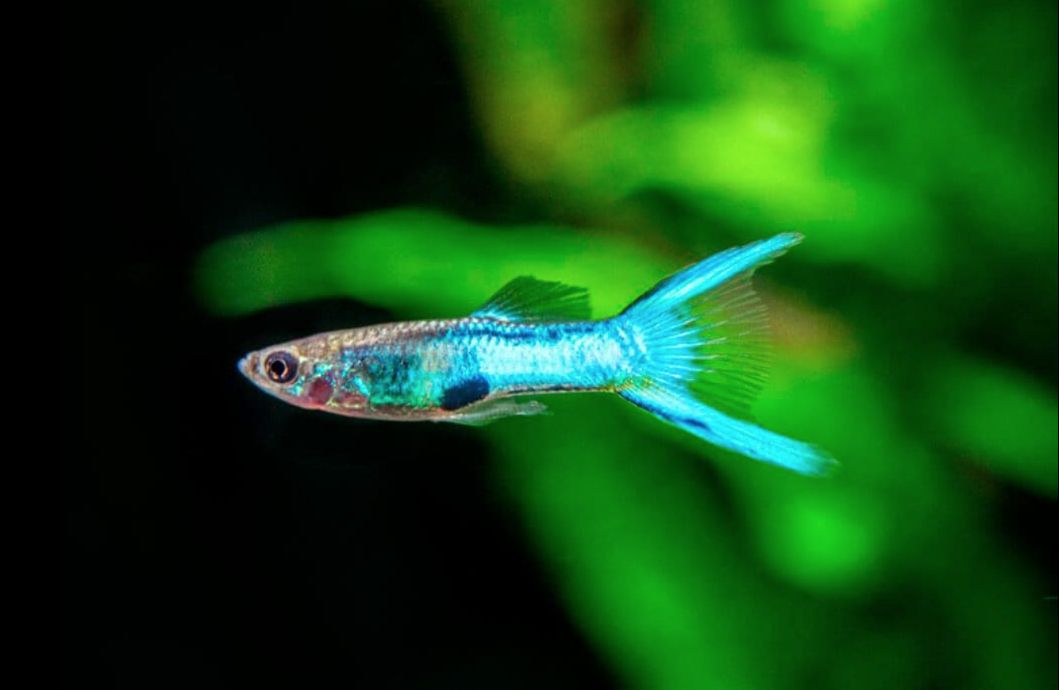
Contents
Habitat in the wild
The Endler guppies (Poecilia wingei) belong to the family Poeciliidae, commonly known as livebearers. This family includes various species of freshwater fish known for their ability to give birth to live, free-swimming fry, as opposed to laying eggs.
The Poeciliidae family is diverse and includes several well-known aquarium species, including guppies (Poecilia reticulata), mollies (Poecilia spp.), swordtails (Xiphophorus spp.), and platies (Xiphophorus spp.). These fish are popular among aquarists due to their vibrant colors, interesting behaviors, and ease of care.
Endler guppies, specifically, are a subspecies of the common guppy (Poecilia reticulata). While they are closely related, Endlers are distinct in their appearance and have become sought-after for their unique color patterns and smaller size.
South America is endler guppy natural habitat. First, this fish was discovered by Franklyn F. Bond in 1937 in Lagoa dos Patos on the North Coast of the continent, on the North of Venezuela. In their natural habitat, Endler guppies can be found in shallow, slow-moving bodies of water with dense vegetation, such as streams, ditches, and small pools.
Unfortunately, this endemic species didn’t attract any interest among the scientists, and for some unknown reasons, it was considered extinct for a long time. However, 40 years later, this species was discovered again by Prof. John Endler, who described it.
Initially, the water in Lagoa dos Patos was brackish because some time ago, it was part of the sea. However, as time went on, it was separated from the ocean by a sand mound that turned the lagoon into a salt-water lake. For many years salty water was being diluted with precipitations such as rain until it became a freshwater lake.
We should mention that there is still no agreement for Poecilia wingei and common guppy (Poecilia reticulata) scientific classification. Some scientists consider these fishes to be treated as the same species because they get fertile offspring after interbreeding these two fishes. Another fact that supports their point of view is that the natural habitat of both fishes partially coincides. Nevertheless, nowadays, Endler’s guppy and common guppy are still considered to be different species.
What is the most interesting, it’s that despite the partial coincidence of their natural habitat, no distant hybridization between these species has occurred? This can be explained very easily: biotopes where common guppy and Endler’s guppy dwell are different. Common guppy prefers relatively strong and chilly water flow, and Endler prefers warm and lentic habitats.
The natural habitat is quite small. Due to active human activity, these species are endangered and are very likely to become extinct.
For some reason, the fish kind hasn’t been included in the international endangered species list. At the same time, its natural population is doomed to disappear due to disposal sites approved by local authorities located along dos Patos that pollute local waters. The natural fish population has remained only in one of four lakes where earlier it was found. Doctor Endler, who was the first to describe this guppy kind, considered that they inhabit other waters within the territory, including the area where the peninsula joins with the continent. However, none of these were found.
| Characteristic | Description |
|---|---|
| Size | Typically smaller than common guppies, ranging from 1-1.5 inches in length |
| Lifespan | Average lifespan of 1.5 to 2 years, although some individuals can live longer with proper care |
| Body Shape | Slender and streamlined body shape, well-suited for swimming |
| Coloration | Endler guppies exhibit a wide range of colors, including vibrant reds, blues, oranges, greens, and metallic hues |
| Fin Variations | Varied fin shapes and sizes, including fan-shaped, pointed, and lyre-shaped fins |
| Males vs. Females | Males display more elaborate coloration and patterns on their body and fins, whereas females are generally less colorful |
| Behavior | Endler guppies are active swimmers, constantly exploring their environment and engaging in social interactions |
| Water Parameters | Temperature: Endlers prefer a temperature range of 75°F to 82°F (24°C to 28°C) |
| pH: They thrive in slightly alkaline water with a pH range of 7.2 to 8.0 | |
| Water Hardness: They can tolerate moderate to hard water conditions | |
| Diet | Endler guppies are omnivorous and have a versatile diet. They enjoy a mix of high-quality commercial flakes, pellets, and occasional live or frozen foods such as brine shrimp, daphnia, or bloodworms |
| Compatibility | Endler guppies are generally peaceful and can coexist with other small, non-aggressive fish species. They thrive in community tanks |
| Breeding | Endler guppies are livebearers, meaning females give birth to live fry. They are prolific breeders and can reproduce at a young age |
| Tank Requirements | A well-planted tank with plenty of hiding spots, such as dense vegetation and driftwood, provides security for Endler guppies. They also benefit from a gentle water flow, which mimics their natural habitat |
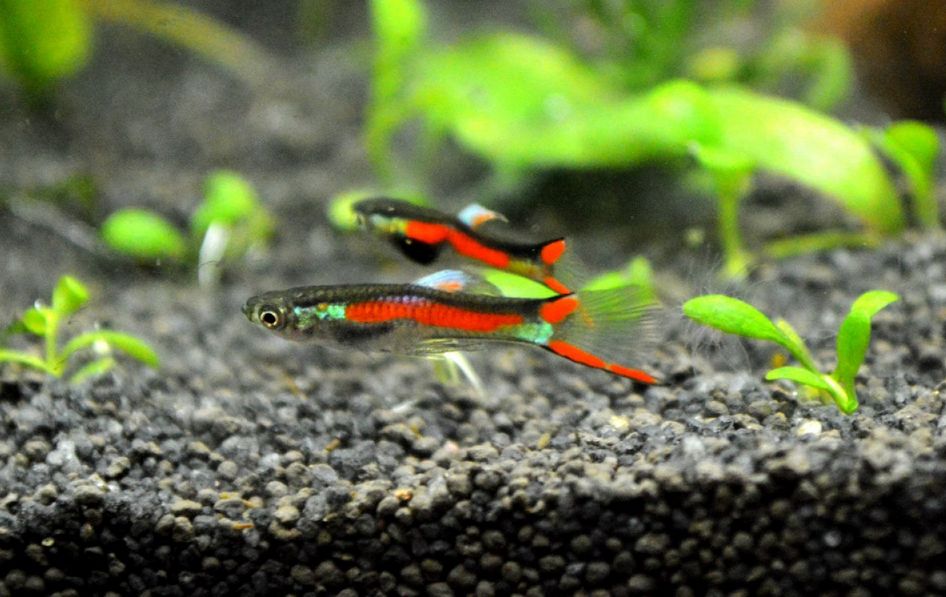
Description
How big do endler guppies get?
Endler guppies (Poecilia wingei) are generally smaller in size compared to common guppies (Poecilia reticulata). This fish’s distinctive feature is its tiny size – male isn’t larger than 1 inch (2–2,5 cm), female fish can grow up to 1.4 inches long (3,5 cm). It makes them well-suited for smaller aquariums or community tanks where space may be limited. Additionally, their smaller size adds to their charm and makes them an appealing choice for aquarists who prefer smaller fish species.
How long do endler guppies live?
As for the endler fish lifespan in a tank, it varies from 1 to 2 years. Often the females live about 6-12 months longer than males. Tank water temperature is a crucial factor in this respect. The higher is the temperature, the faster are metabolic processes of the fish, which decreases its lifespan correspondingly.
The female fish coloring is sole-colored with golden or silvery tint. Behind its abdomen, there is a small spot, which indicates that they have some embryos inside.
Due to long-term selective breeding programs, some Endler’s guppy breeds, which you won’t encounter in the wild. Gold Endler guppy has a very interesting coloring – a golden body of the fish male has small red spots on it and an emerald-green spot near its tail. The edges of its tail fin are red as well, and it is transparent in the middle.
One of the most beautiful colors of Endler fish is japan blue. The fish body and tail are light-blue with a black spot on the body side, and the head is silvery colored.
Unfortunately, it is impossible to describe all existing Endler fish types. Here is the list of the most popular colorings and kinds:
Types of endler guppy
Endler Guppy El Silverado
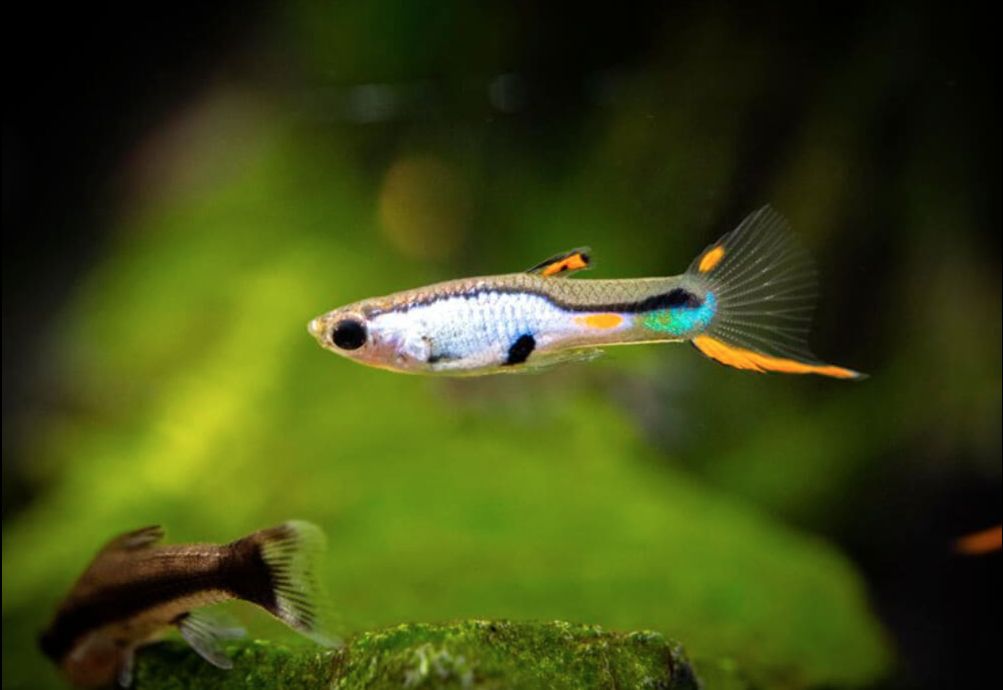
Endler Guppy Red
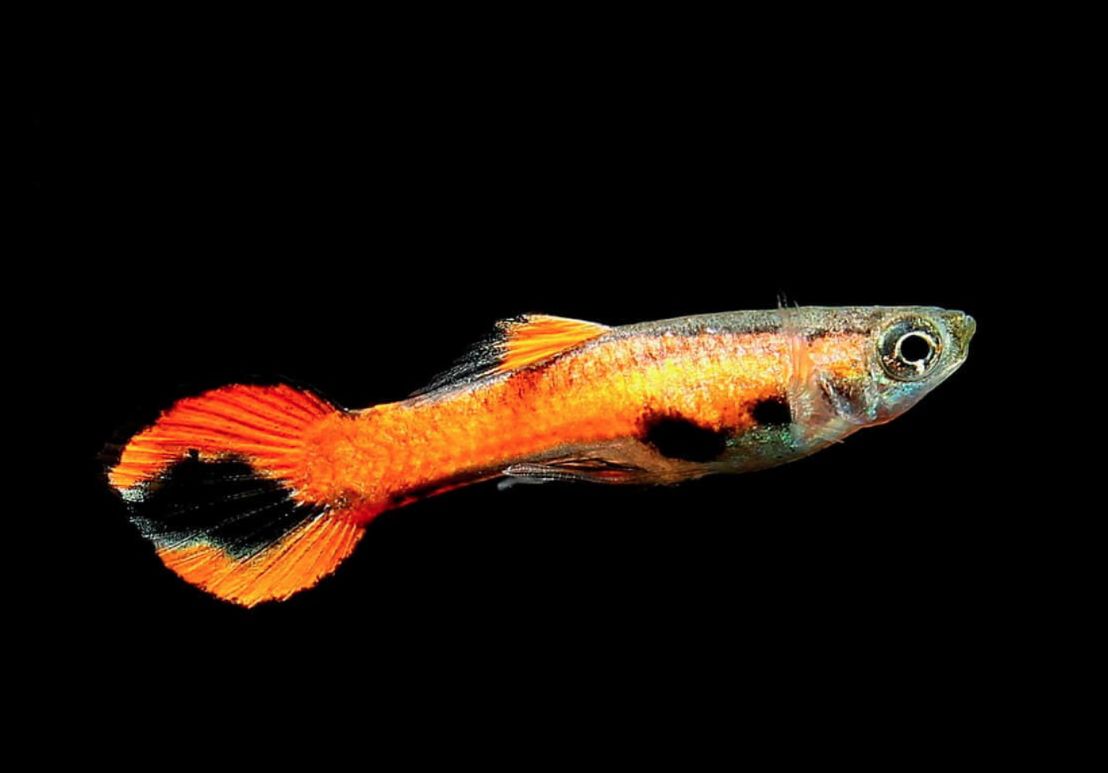
Endler Guppy Black Bar
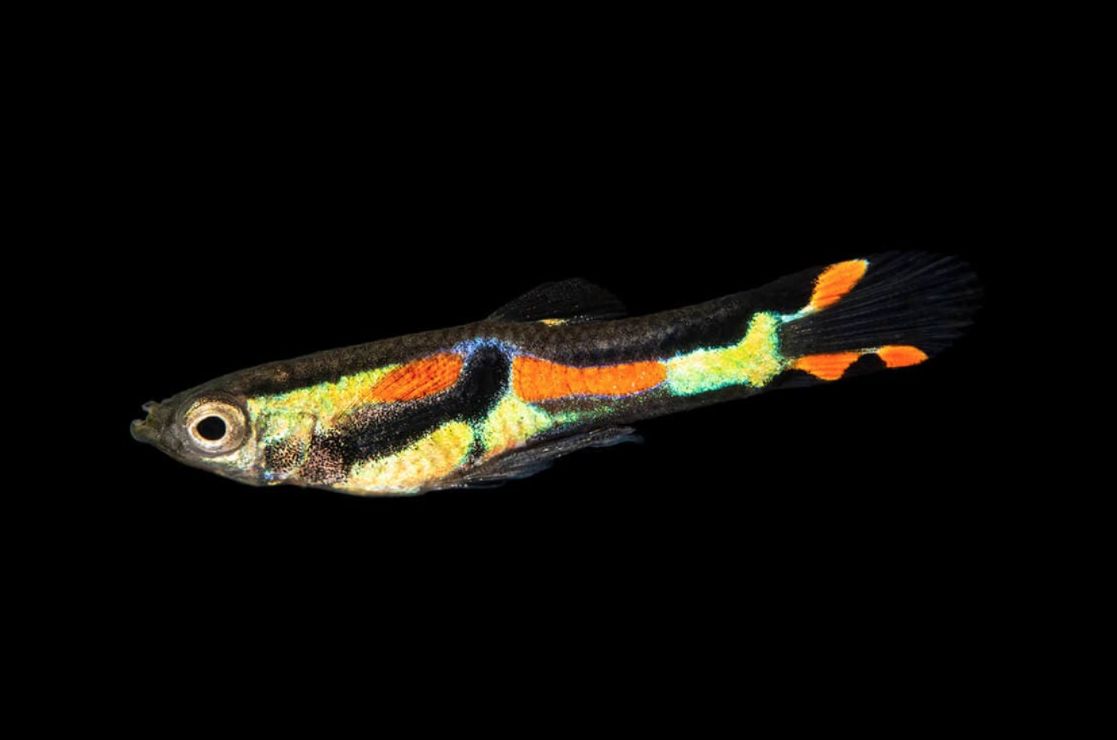
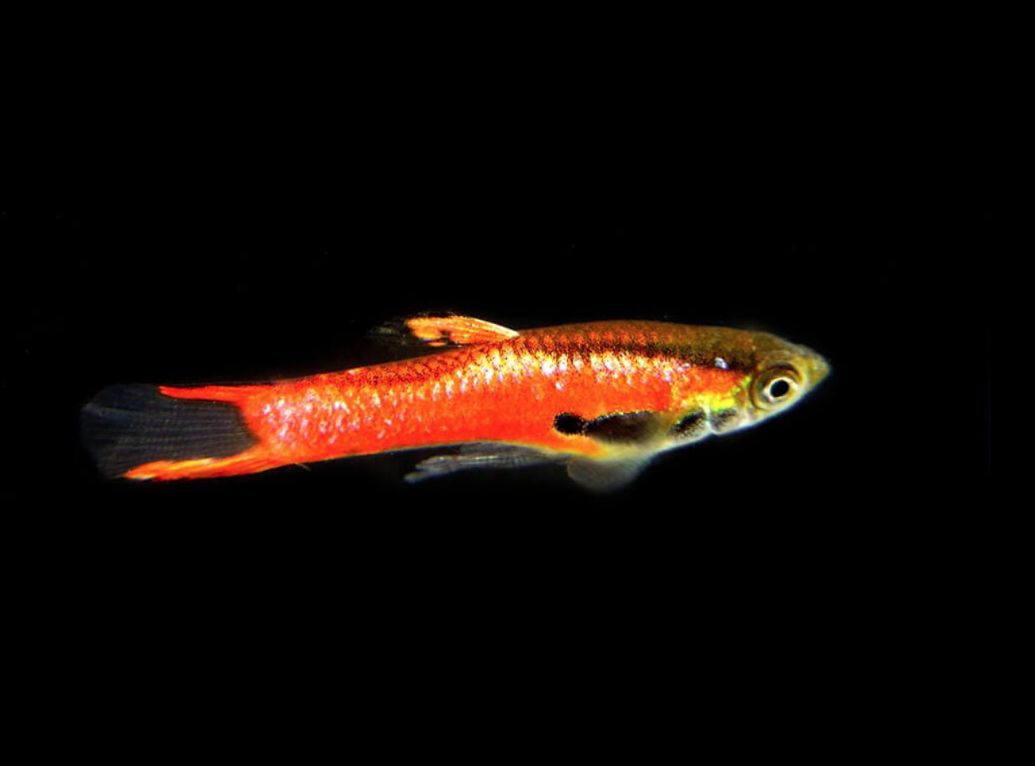
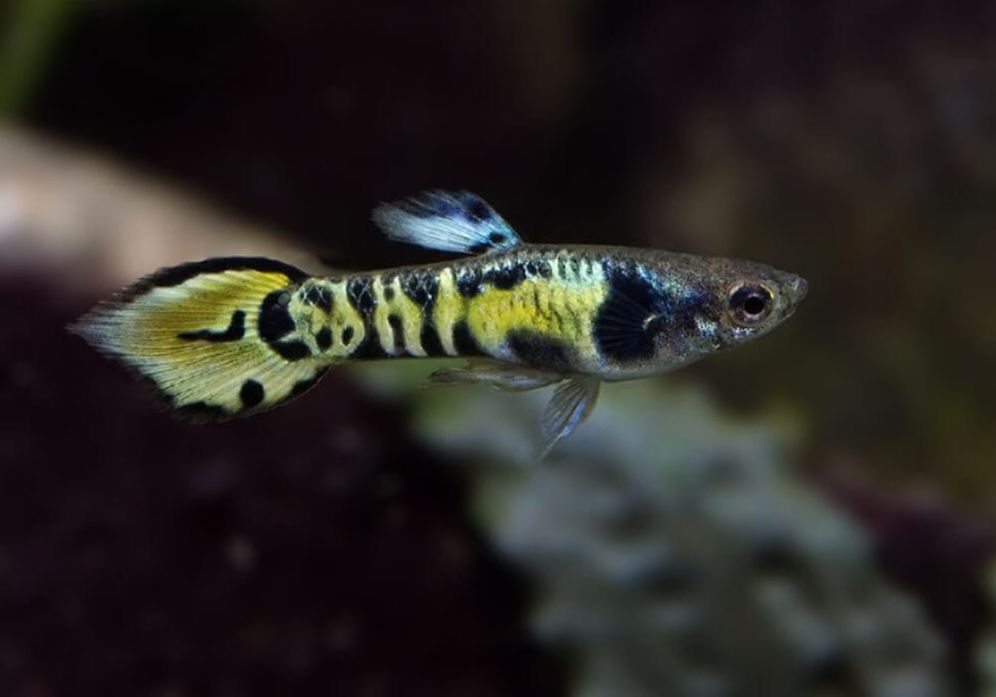
Endler Guppy Chili Scarlet
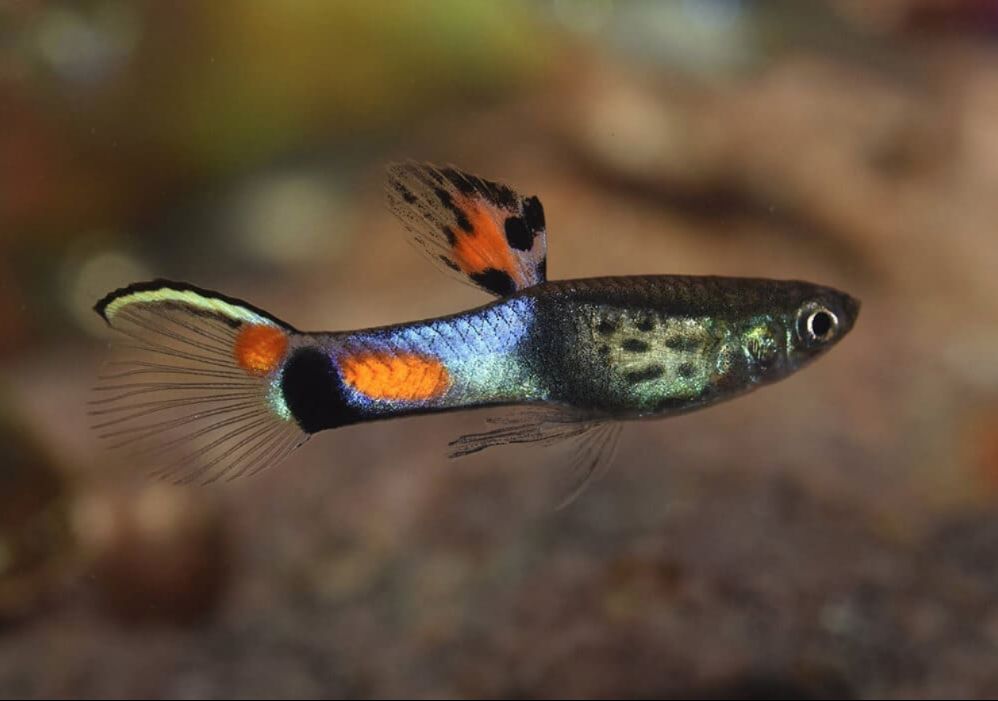
Endler Guppy Orange
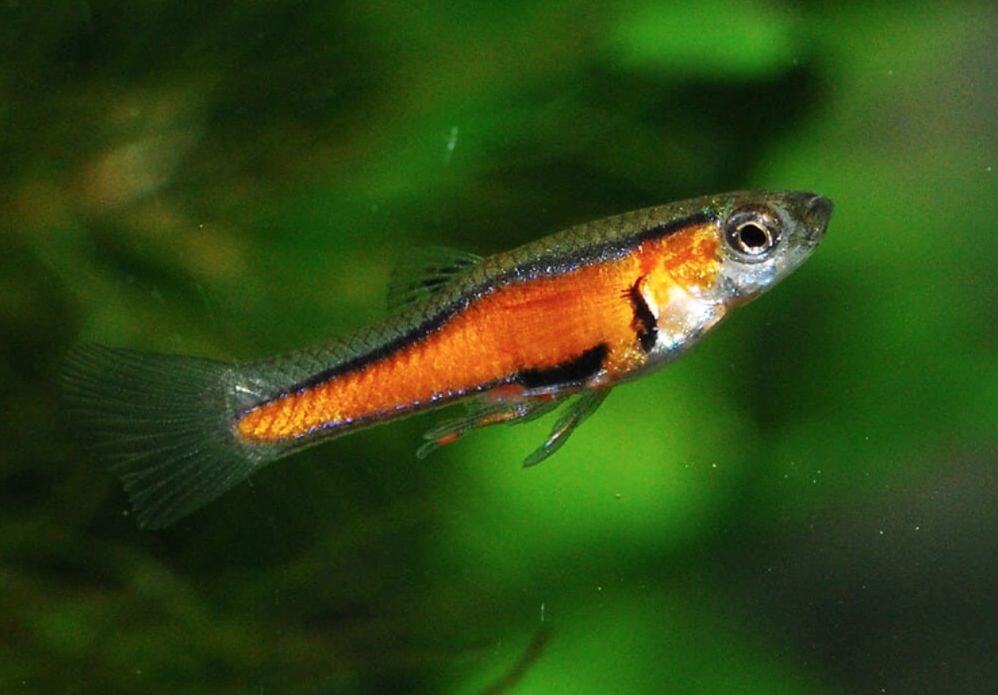
Endler Guppy Red Scarlet
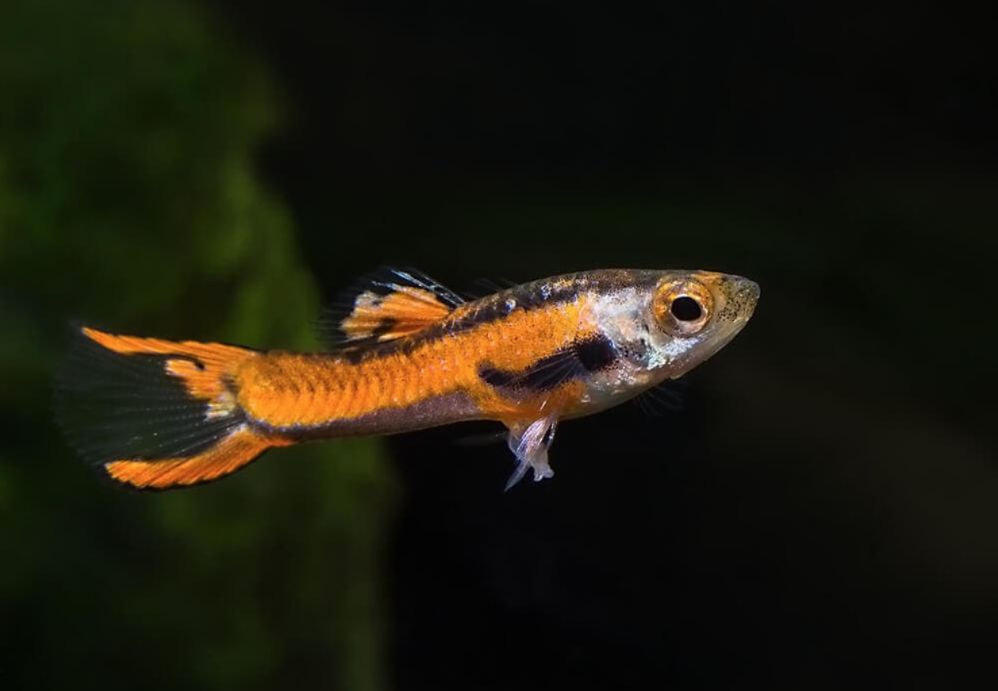
Endler Guppy Lime Green
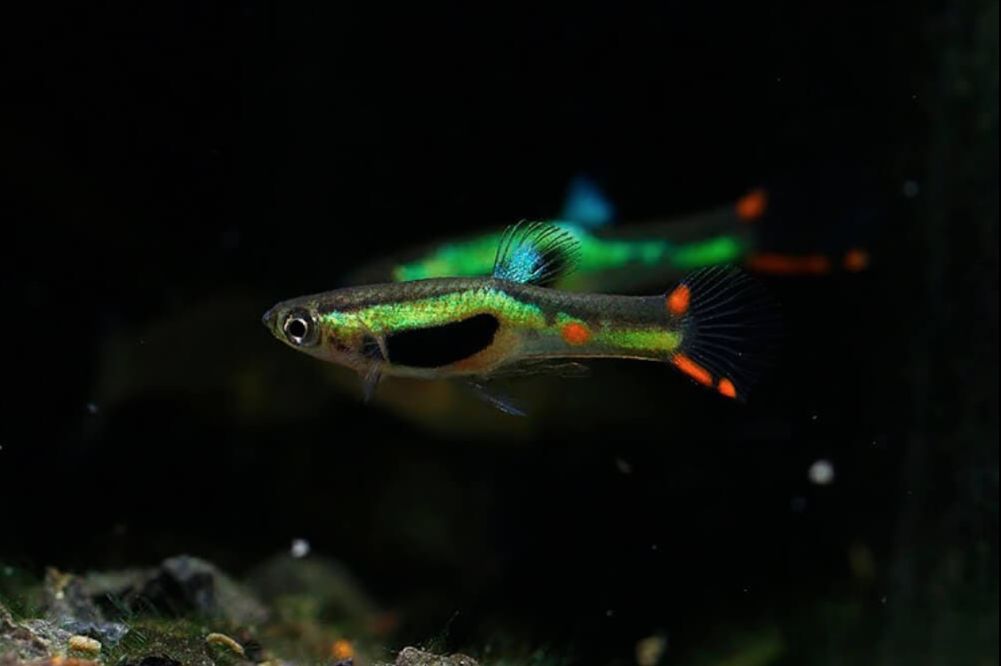
Endler Guppy Gold
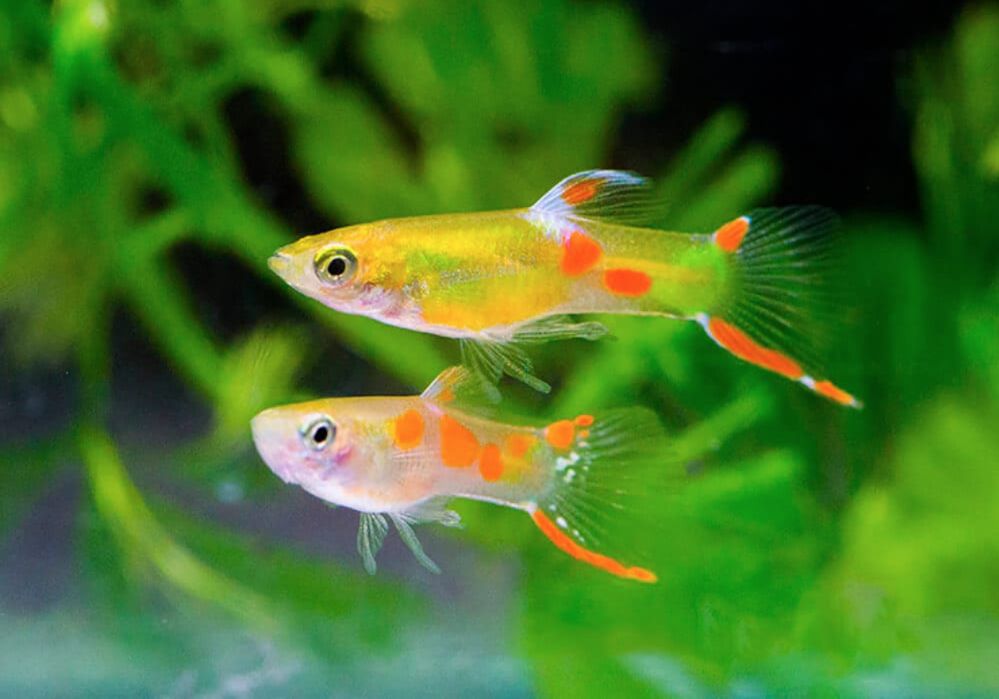
Endler Guppy Campoma Blue Star
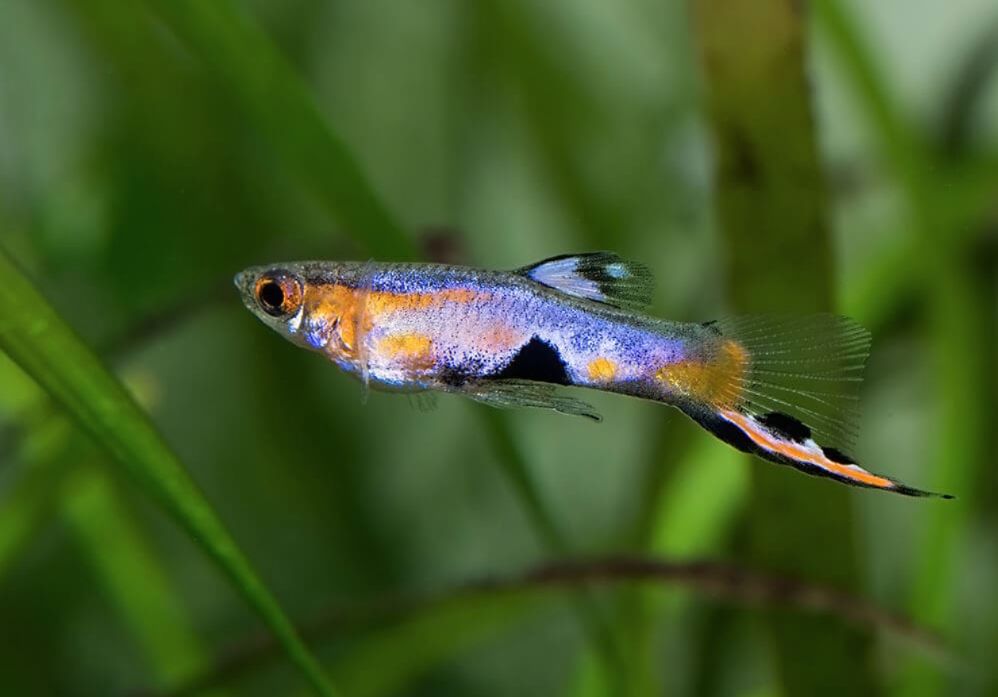
Endler Guppy Japan Blue
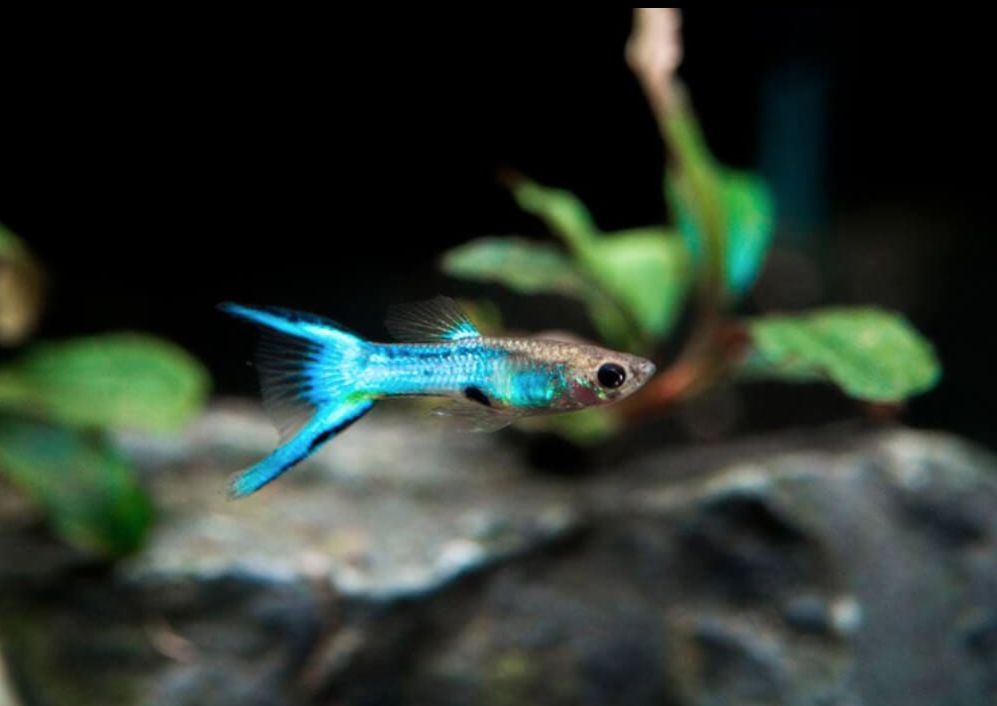
Endler Guppy Ginga Rubra
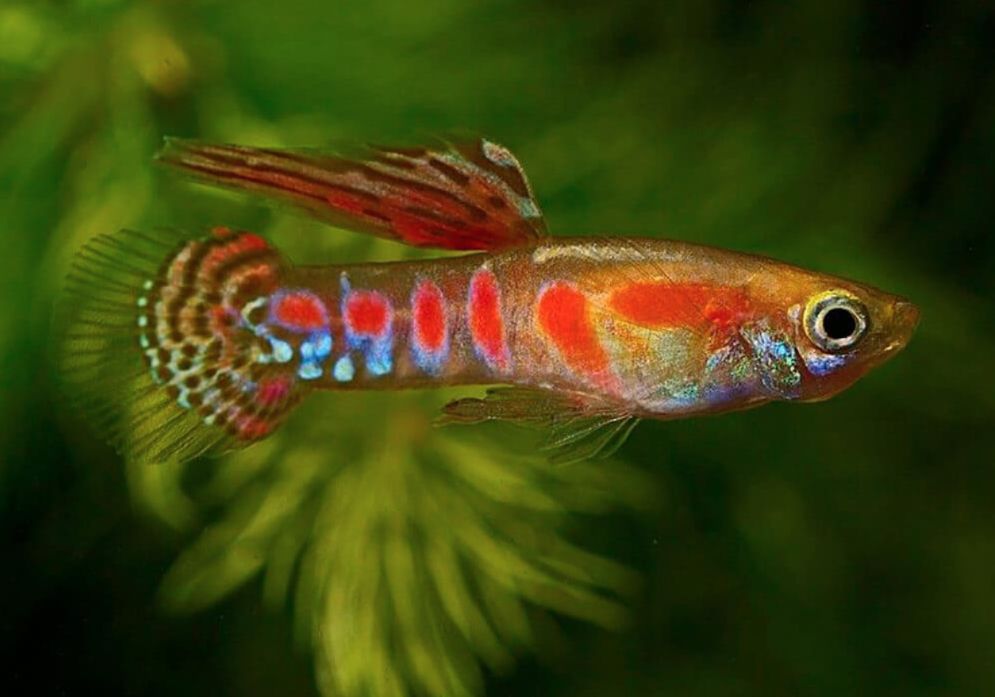
Difficulties in keeping
These tiny fishes are extremely easy to keep. They prefer dwelling in a school, and for a home tank, you should get two or three fish couples. A small tank will be enough for them, and they are not demanding in terms of tank water parameters.
They are very active; therefore you should buy several couples at once. Also, if you don’t want to get some mixed offspring later, don’t put different species in one tank. It’s possible to keep only various species of male fish in the same tank.
Another thing you should keep in mind is the proper ratio of male and female fish in the tank (1:3 or 1:2). Otherwise, the male fish will haunt the female fish all the time, and this negatively affects the health of the latter.
Care and keeping in a tank
Tank size
The recommended tank size for Endler guppies (Poecilia wingei) depends on the number of fish you intend to keep and the available space. While Endler guppies are small in size, it is essential to provide them with adequate swimming space and a comfortable environment. A larger tank offers more stability and allows for better water parameters.
Due to their size, endler guppy fishes are perfect inhabitants for nano tanks. As a general guideline, a minimum tank size of 10 gallons (38 liters) is often suggested for a small group of Endler guppies. However, they will do with a much smaller tank, but considering the idea of keeping them in a school and breeding in the future, it’s better to stick to the initial recommendations.
However, if you plan to keep a larger group or include other fish species in the tank, a larger aquarium is recommended. A 20-gallon (75 liters) tank or larger can accommodate a more substantial number of Endler guppies while providing ample swimming space and a better environment for the fish to thrive.
The tank must be covered since the fish may jump out of the water.
Are endlers livebearers schooling fish?
Yes, Endler guppies are livebearers and are known to exhibit schooling behavior. In their natural habitat, Endler guppies often form loose schools or groups, especially when foraging or seeking protection from predators. They feel more secure and less stressed when they are in the company of their own kind.
In an aquarium setting, Endler guppies can also display schooling behavior. Keeping them in groups or schools of their own species is beneficial for their well-being and can help reduce stress. A small group of Endler guppies, consisting of multiple females and a few males, is recommended to promote social interaction and mimic their natural behavior.
How many endlers should be kept together?
When it comes to keeping Endler guppies together, it’s generally recommended to have a ratio of more females to males. This helps to prevent excessive male competition and reduce the chances of female stress due to male harassment. A commonly suggested ratio is to keep around 2 to 3 females for every male in the aquarium.
The specific number of Endler guppies that can be kept together depends on factors such as the size of the tank and the overall setup. As a general guideline, a minimum tank size of 10 gallons (38 liters) is recommended for a small group of Endler guppies. In a tank of this size, you could keep a small group consisting of 1 or 2 males and 3 to 6 females. It’s important to provide enough space and hiding spots for the fish to ensure their well-being and minimize stress.
If you have a larger tank, you can consider keeping a larger group of Endler guppies. Just remember to maintain the male-to-female ratio to avoid excessive aggression and ensure a harmonious environment.
Additionally, it’s always a good practice to monitor the behavior and well-being of the fish. If any signs of aggression or stress are observed, adjustments may need to be made to the group size or ratios.
Water parameters
Keeping Endler’s guppy in a tank is a very simple thing – the fish isn’t demanding as for tank water parameters. Here are the optimal tank conditions:
- The optimal temperature range for Endler guppies is between 75°F and 82°F (24°C to 28°C). Keeping the water within this range helps promote their overall health, metabolism, and breeding activities. We should mention that keeping Endler’s guppy at a temperature of about 30°C speeds up its metabolism and thus decreases its lifespan.
- Endler guppies can tolerate a moderate to hard water hardness. Aim for a range of around 10 to 2
- Endler guppies thrive in slightly alkaline water conditions. The recommended pH range for them is typically between 7.2 and 8.0.
Tank setup: decorations and plants
When it comes to decorating the aquarium for Endler guppies, there are various options to consider. Creating a visually appealing and functional environment can enhance their well-being and provide them with hiding places and enrichment.
Here are some decor ideas:
- Live Plants: Endler guppies thrive in planted tanks. Adding live aquatic plants like Java moss, Amazon sword, Anubias, or Hornwort not only enhances the aesthetics but also provides hiding spots and resting places for the fish. Plants also help maintain water quality by absorbing excess nutrients. The tank should be planted with small-leaved plants, and some areas should be left free for the fish to swim.
- Floating Plants: Floating plants like Water Sprite, Water Lettuce, or Amazon Frogbit offer shade and cover, which Endler guppies appreciate. Floating plants also help diffuse lighting and create a natural environment. The fish feels very comfortable in tanks with floating plants. They then become a shelter for endler guppy juveniles.
- Driftwood and Rocks: Natural driftwood pieces or rocks can be strategically placed in the aquarium to create caves, crevices, or elevated areas. Endler guppies can explore these structures, hide, and seek shelter when needed.
- Substrate: A fine-grained substrate like sand or small-sized gravel is suitable for Endler guppy tanks. Substrate provides a natural-looking base and allows for the growth of beneficial microorganisms.
- Open Swimming Space: While it’s important to provide hiding places, it’s equally important to have open swimming areas for the active nature of Endler guppies. Leave enough space in the aquarium for them to swim freely.
Remember to arrange the decor in a way that allows for easy maintenance and cleaning. Regular maintenance, including trimming plants, removing debris, and monitoring water quality, will help create a healthy and aesthetically pleasing habitat for your Endler guppies.
Filtration
To keep the tank clean, a small internal filter not creating a strong water flow is enough. You should renew about 25-30% of the water amount weekly. Since the abrupt change of tank water temperature and quality negatively impacts the fish males’ fins, it’s desirable to perform water renew often, but in small amounts.
Diet
When selecting the food, you should consider that the fish has a small mouth and spend most of their time in upper and middle water layers in a tank. Also, for the proper functioning of their gastrointestinal tract, plant components must be present in the food.
In the wild, Endler’s guppy diet includes various food such as maggots, small worms, and algae. In a tank, you can feed the fish with artificial, live food, vegetable flakes, dry food with vegetable supplements, live and frozen maxillopods (small daphnia, cyclops, bloodworm). As for inferior plants, you can include spirulina into the fish diet. Endler’s guppy is prone to obesity. That’s why you shouldn’t overfeed it.
When keeping in the tank, it is important to provide the endler guppy with diversified food. To do this, you can use quality artificial food. It is safe, well-balanced, contains various additives, for example, color boosters or spirulina. A staple part of their diet can be high-quality commercial flakes or pellets specifically formulated for tropical fish. Look for products that offer a balanced blend of proteins, vitamins, and minerals suitable for small livebearers like guppies.
Tank mates
This guppy fish prefers swimming in upper water layers, and it is a good tank mate for all non-aggressive fishes.
Due to the fish size, you should keep it only with small and peaceful fishes. In general, Endler guppy is a peaceful and harmless fish, which can suffer from other fishes. It can get along well with common shrimps and with small ones (like a cherry shrimp), too.
Endler livebearer are generally peaceful and can coexist with a variety of other peaceful fish species in a community aquarium. Here are some popular tank mates that can be suitable companions for endler livebearers:
- Harlequin Rasboras (Trigonostigma heteromorpha)
- Neon Tetras (Paracheirodon innesi)
- Ember Tetras (Hyphessobrycon amandae)
- Glowlight Tetras (Hemigrammus erythrozonus)
- Black Neon Tetras (Hyphessobrycon herbertaxelrodi)
- Cardinal Tetras (Paracheirodon axelrodi)
- Rummy Nose Tetras (Hemigrammus rhodostomus)
- Dwarf Gouramis (Trichogaster lalius or Trichogaster chuna)
- Sparkling Gouramis (Trichopsis pumila)
- Celestial Pearl Danios (Danio margaritatus)
- White Cloud Mountain Minnows (Tanichthys albonubes)
- Dwarf Rasboras (Boraras spp.)
- Guppies (Poecilia reticulata)
- Platies (Xiphophorus spp.)
- Corydoras Catfish (Corydoras spp. – pygmy cory, panda cory, adolfoi catfish)
- Otocinclus Catfish (Otocinclus spp.)
- Bristlenose Plecos (Ancistrus spp.)
While Endler guppies are generally peaceful and can coexist with many species, there are some tank mates that may not be suitable due to potential aggression, size differences, or incompatible care requirements. Here are some examples of tank mates that are generally not recommended to be housed with Endler guppies:
- Aggressive Fish: Avoid keeping Endler guppies with aggressive or territorial fish species such as large Cichlids (e.g., Oscars, Jack Dempseys), aggressive barbs (e.g., Tiger Barbs, Rosy Barbs). These species may harass or nip at the Endler guppies.
- Fin-nipping Fish: Some fish species have a tendency to nip at the fins of other fish. Avoid housing Endler guppies with fin-nippers such as Tiger Barbs, Serpae Tetras, or Redtail Sharks. These species may damage the fins of the Endler guppies.
- Large Predatory Fish: Endler guppies should not be kept with larger predatory fish that may view them as prey. Examples include predatory catfish like Redtail Catfish or Clown Knifefish.
- Incompatible Water Parameters: Endler guppies prefer similar water parameters to their potential tank mates. Avoid pairing them with species that have significantly different requirements, such as fish that require extremely soft or acidic water (e.g., Discus) or fish that thrive in brackish water conditions.
Gender differences: male vs female
How to sex endler guppies? Determining the sex of Endler guppies can be done by examining certain physical characteristics. Here are some common methods to help sex Endler guppies:
- Size and Body Shape: Generally, males are smaller and more slender compared to females, which tend to have a larger, rounder body shape. The female fish body is longer and fatter than that of the male fish. They may have some unpronounced spots on them.
- Coloration and Patterns: Male Endler guppies usually exhibit more vibrant and elaborate coloration. They often display striking patterns, such as bold spots or intricate stripes, on their bodies and fins. Females, on the other hand, tend to have less vibrant coloration and may appear more plain. Endler guppy females, as a rule, are rather unpresentable, with silvery or golden bodies.
- Finnage: Males typically have larger, more colorful and elaborate fins compared to females. Their dorsal fins, anal fins, and caudal fins (tail fins) may be elongated and show intricate patterns or vivid colors. Female fins are generally more rounded and less elaborate. The female fish fins are short and rather pale colored.
- Gonopodium: The most reliable method to sex Endler guppies is by examining the gonopodium, a specialized anal fin found only in males. The gonopodium is modified into a reproductive organ used to fertilize females. It is elongated and pointed, resembling a tube-like structure. In contrast, females have a normal rounded anal fin without the elongated tube-like structure.
Breeding
Endler’s guppy breeding is very simple. They breed quite actively in a common tank. Therefore, you just need a couple of fishes for breeding. They will do the rest themselves.
Endler fish is a live-bearing one. This means that their eggs are fertilized and grow inside the female’s body, and it gives birth to completely developed juveniles. For such a way of breeding, their males have a special organ – gonopodium. This is a transformed anal fin that looks like a tube. With its help, the male injects his reproductive products into the female’s abdominal cavity when the eggs get fertilized. An interesting fact is that the female can store these reproductive products for up to three months. Considering that new juveniles appear every 24 days, the female can have up to three offsprings.
Females become fertile at the age of 2 months. Internal fertilization is performed due to gonopodium (a modified anal fin of the male fish). The female fish carries eggs for 22-24 days.
Then she spawns fully formed juveniles (from 10 to 30 small fish). You can also stimulate this process by increasing the tank water temperature by 2 degrees. As a result of one mating, you may get several offspring.
Juveniles are fed with brine shrimp nauplii. For 2 weeks, you should feed juveniles 3 times a day and then switch to feeding 2 times a day. At the beginning of the sixth week, when the male fish become completely colored, you should feed them just once a day.
Adult fish should be put into a separate tank right when the juveniles appear so that they wouldn’t eat the offspring. Or you can put some more moss into the tank, and the juveniles can hide there.
You should feed the juveniles 2-3 times a day. They grow very quickly. The female fish becomes fertile when she is 2 months old. At the age of 3-4 weeks, the males gain their adult coloring, but it gets its maximum intensity and brightness when the juveniles are 6 months old.